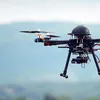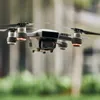India’s Drone Rules 2021 set to help startups, innovation take flight, Amber Dubey, Joint Secretary, Ministry of Civil Aviation, tells YourStory
As the Ministry of Civil Aviation approved the production-linked incentive (PLI) scheme for drones and drone components allocating a sum of Rs 120 crores on September 30, Amber Dubey, Joint Secretary, Ministry of Civil Aviation decodes what the move means for Indian drone startups.
The Ministry of Civil Aviation approved the production-linked incentive (PLI) scheme for drones and drone components, allocating a sum of Rs 120 crores on September 30. Earlier, the ministry announced the Drone Rules 2021 on August 25, 2021.
In an exclusive interaction with YourStory Founder and CEO Shradha Sharma, Amber Dubey, Joint Secretary, Ministry of Civil Aviation, shares how this scheme will help Indian drone startups deal with the challenges in the sector across areas such as funding, clarity of vision, policies and regulations.
The ministry managed to get the PLI clearance within three weeks, setting a record of sorts, as typically a PLI scheme has to go through several rounds of consideration before it can be approved.
“Within three weeks, we managed to get the clearance for the PLI scheme, which itself is a record of some kind because normally most PLI schemes take eight to nine months as they go through several layers of approval. This also shows the importance that sector is getting,” says Amber.
That the ministry did away with typically archaic processes in favour of a fast-tracked PLI scheme only goes on to show how the government is all for providing an enabling policy environment to boost indigenous drone manufacturing. Will this dramatic productivity boost help the sector scale up and take a flight of diversification, innovation and entrepreneurship?
With the government now on a mission to have drones up by 2030, Amber talked about focusing on startups while formulating policies around regulations, job creation and more. Watch the full video conversation here.
Going back to the drawing board
The PLI scheme is a follow up to the liberalised drone rules enacted in August.
In August, the Ministry of Civil Aviation notified the updated Drone Rules 2021, replacing the highly critiqued Unmanned Aircraft System (UAS) Rules, 2021, released on March 12, 2021.
This was following extensive feedback from the industry stakeholders, which Amber says “was scathing and not very parliamentary.”
“We had the humility and the humbleness to go back to the drawing board, understand, talk less and listen more and based on that, we came up with the Drone Rules 2021 on August 25,” he says.
The liberalised Drones Rules 2021, along with Rs 120 crores in the hands of domestic manufacturers for the next three years, is likely to put India on the path to becoming a global drone hub by 2030.
Giving a broad contour of the PLI scheme, the Joint Secretary emphasises on its unique differences, which set it apart from the other sectors. Being at a nascent stage, he goes on to term the sector as the government’s “special child”, with a stress on special incentives and rules.
Some of the key highlights are:
- The PLI scheme allocates Rs 120 crore for drones and drone components spread over three financial years — almost twice the combined turnover of all domestic drone manufacturers in FY 2020-21.
- The incentive for a manufacturer of drones and drone components will be 20 percent of the value addition. The PLI rate at a constant 20 percent for all three years is an exceptional treatment given only to the drone industry. In PLI schemes for other sectors, the PLI rate reduces every year. “For someone who is doing 70-80 percent value addition, can get 20 percent of that 80 percent, which is 16 percent. This is a very high number. In most of the PLI schemes, it starts at the peak of five percent of the incremental sales that you do this year vis-a-vis the base year,” he says.
- The government has agreed to fix the minimum value addition norm at 40 percent of net sales for drones and drone components instead of 50 percent, another exceptional treatment given to the drone industry, given its infancy. “We are still dependent on a lot of these imports from China, Europe, Taiwan and a couple of other countries. So, instead of putting 50 percent, we argued and it was accepted by the Finance ministry and then the cabinet. The whole idea is to widen the base of people who qualify,” he says. Also, the value addition will be calculated as the annual sales revenue from drones and drone components (net of Goods & Services Tax {GST}) minus the purchase cost (net of GST) of drone and drone components.
- The proposed tenure of the PLI scheme is three years starting in FY 2021-22. The PLI scheme will be extended or redrafted after studying its impact in consultation with the industry.
- The eligibility norm for non-medium to small enterprises (MSME) companies in terms of annual sales turnover has been kept at Rs 4 crore (for drones) and Rs 1 crore (for drone components). For MSME and startups, it is kept at Rs 2 crore (for drones) and Rs 50 lakhs (for drone components). “Rs 50 lakh is hardly anything! It means that anybody who is manufacturing something in India will automatically qualify,” says the official.

Designed for startups, by startups
It was all about “more listening and less talking” for the government when it came to drafting the policy, which has been framed following extensive feedback from industry stakeholders, especially startups.
“The whole scheme has been designed by talking less and listening more from the startups. I would go to the extent of saying that the scheme is designed by the startups themselves. We received so many useful inputs and all have gone into the scheme. That is why this scheme is so different from the others,” he says.
The officials aim to continue this productive flow of communication with the startups and revisit the rules after every few years, given the ever-changing ecosystem.
This is also one of the reasons why the scheme has been devised for three years against the usual five-year norm in other mature sectors like pharma, textiles, auto and so on, where the industry issues are predictive.
“Here, we are acknowledging the fact that our wisdom is limited. Nothing wrong with that given the ever-evolving technology. Once two years are over, we will take a little pause and again go back to the startups and the beneficiaries and see how this has gone up. Based on that we will come up with another draft scheme for the next three or five years,” says the Joint Secretary.
“So, everything which is there is coming from listening to the industry and finding a way to help them out,” he adds.
As per a January 2020 PWC report, the drone market in India is predicted to grow at $885 million by 2021 and to $9.96 billion by 2027, growing at a compound annual growth rate (CAGR) of 25.05 percent between 2020 and 2027.
Estimated to have crossed the 50 mark, Indian drone startups played a significant role during the COVID-19 pandemic enabling not only medicine and vaccine supply but also cutting acroos sectors like logistics and ecommerce. Some of the players include Drones Tech Lab, Aarav Unmanned Systems and Aero 360. The artificial intelligence (AI) and machine learning (ML) startup, Detect Technologies, is a drone-as-a-service deeptech company that helps manufacturing industries ensure 'asset integrity". Another deeptech (a generic term for AI, robotics, blockchain etc) startup Cron Systems builds defence equipment including intrusion detection systems and drones.
Employment opportunities and new verticals for drone utilisation
The incentivised drone sector is reportedly going to be of Rs 900 crore by 2023-24 and expected to employ 10,000 people in the coming years. The official pointed out how India is traditionally poised to value-add to the sector.
“Let me clarify why we are very bullish about the value-add part - it’s because in any drone, like your laptop or your phone, the value of the physical components is just 10, 15 or 20 percent, while 80 percent of the value comes from the apps that are there, the software, the brain part, the intellectual property (IP) — essences which have gone into your laptop, your personal computer (PC), or your mobile phone — that’s where the value comes from. And that is where India has a very big traditional strength and that is why the government is pushing it so much,” the Joint Secretary clarified.
On the numbers front too, the government is bullish on the basis of feedback received from various drone startups. “Of course, somebody will say 10x, somebody will say 50x, somebody will say 40x, but based on a lot of debate and discussions with the drone industry, we finally arrived at this target of going from 60 to 15x in just about three years. So, Rs 50 or Rs 60 crore become Rs 200, Rs 400 and Rs 900 crore. So, as I said, this is just a prediction and we will be happy if we are proved completely wrong on the positive side. And, hopefully, the Rs 900 crore will even become Rs 1,000, Rs 2,000 or Rs 3,000 crore. If it increases, we will go back to the finance ministry, and we have been given the assurance that they will consider us favourably and that if the numbers justify we will again get more funding,” he said.
The ministry will have a special focus on sectors where drones can aid functionality, last-mile delivery help with averting critical delays and risks and these include agriculture, mining, medicine supplies, combat, firefighting, rescue operations, construction site activities as well as surveillance.
“We can talk about medicine delivery, especially in Northeastern areas and hilly areas where if one person in the village dies, the whole family gets devastated,” points out Amber. And this arises due to the “golden hour” concept. So, a drone can aid delivery within a few minutes, which would otherwise physically take hours by road given the long, arduous hilly tracks.
Apart from drones for medicine supplies, the official also highlighted pushing drones in the fields of surveillance, combat, cargo delivery as well as Kamikaze drones, and these are areas where the government is pumping in a lot of money.
To aid the above vision, the government has already done away with a lot of processes. While the ministry in its latest move has already removed 20 out of 25 forms required, it has also simplified the fee items.
Out of 72 fee items, as many as 68 fee items have been done away with in a bid to revive the sector suffering from ‘policy paralysis’ and under the weight of bureaucratic red tapeism. Out of the four existing fees, three fees pertain to a value of Rs 100 and some of them offer a lifetime value.
“Some fees like pilot license are for 10 years, so Rs 100 divided by 10 years is like Rs 10 per annum,” added Amber.
Owing to a lack of clarity in terms of regulations and policy, venture investors have stayed away from placing their bets on the Indian drone startups. The latest move can finally give this ‘sunrise sector’ the much-needed wings to fly, and encourage more and more startups to join the ecosystem. One can only be hopeful that this will further accelerate a climate of entrepreneurship, innovation, competition, job creation, imagination and harness future-ready technology in doing so. Can drones, termed as products of the “fourth industrial revolution”, propel India to be a globally positioned hub? Only time will tell.
Edited by Anju Narayanan









